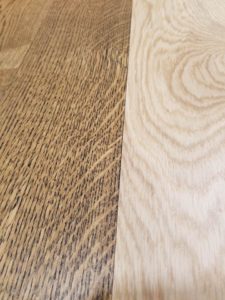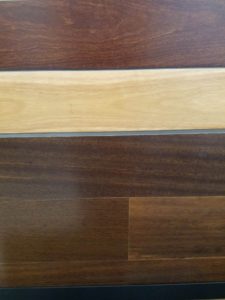Engineered wood flooring has been embraced by Europe for years and New Zealand has been fast to follow suit and introduce this innovative flooring solution down under. Below are some of the key benefits surrounding engineered wood flooring and the comparison with solid wood flooring.
So, what is engineered flooring?
Engineered wood flooring is processed in a factory overseas where the wood is treated and coated before it makes its way to New Zealand. It arrives ready to lay straight away and doesn’t require any further sanding or oiling on installation (unlike solid wood flooring). Made from 100% real wood, engineered wood flooring comes in two variations. The first being multi-ply – a hardwood top layer with a plywood backing. The second option is a 3-ply solution consisting of two backing layers of spruce or birch, finished with a top layer of hardwood.
Benefits:
Cost – Understanding your costs is easier when it comes to engineered wood as most of it will be supplied with the colour and finish already complete. Solid wood on the other hand, will be supplied in raw form and needs to be finished on site, meaning the cost of extra labour ($50 – $60 m2) will occur.

Life-span – Engineered wood is designed to last over 45 years with the ability to sand the top layer several times which can be as deep as 4mm-6mm. For a natural finish, engineered wood can be simply maintained through regular oiling. Solid wood planks can require more excessive sanding to get a smooth, even finish but will last around the same amount of time as engineered flooring.
Surface Treatments – you will be amazed by the extensive list of treatment options for engineered wood. Bringing out a certain style and beauty in wood is a real art-form which can be achieved in so many ways. Completed overseas and delivered to New Zealand, engineered wood comes in a range of finely crafted textures, shades, glosses, and sizes. Solid wood can of course look traditionally elegant but the tools available in New Zealand leave little space for creativity. Sanding followed by staining or oiling are your main options. With the overall finish of each product, engineered wood, simply out-rivals solid wood.

Finishing – Engineered wood is finished in a factory and defined by state-of-the-art tools, setting a standard which simply can’t be beat by physical labour. Humidity levels, quality of finishing products, and the actual skill of a floorer are all factors which can make or break a flooring project using solid wood.
Health – Engineered wood is treated in a factory and by the time it makes its way to our shores any fumes are long gone. Laying solid wood requires sanding and coating which can both be detrimental to your health. In fact, many people will move out of their home for days or even weeks when their solid wood floors are being worked on.

Timeframe – The beauty of engineered flooring is all the finishing is done in the factory, meaning it is ready to go as soon as it’s installed. It can literally go from the truck straight down to the floor and furniture can even be installed a mere 24 hours after completion. Solid wood planks take a lot more preparation however with the need to deliver them to the location a few weeks in advance to give the wood time to adjust to temperature levels to avoid gaps, cupping, and warping. The process to acclimatise, install, sand and finish solid wood can take significantly longer than the simple installation of a pre-finished engineered wood floor.
Milling Precision – Engineered Wood lives up to its name. The milling process, most often carried out overseas, means that the wood is engineered in such a way that the not only do the grains match up but planks themselves fit to perfection too. Solid wood flooring simply can’t compete with the slick finish of engineered flooring which delivers an elegant and high-end finish to any property.

Plank Width – simply put, engineered wood is available in a wide width if desired and will deliver. The multi-layered construction allows them to adapt to many environments with ease. Solid wood does not lend itself well to wide planks however, due to the movement and expansion it has in changing room temperatures.
When making decisions for your next wooden flooring project, consider all the points above. It comes down to what overall look you are trying to achieve, what timeframe and costs you are willing to work with and how much maintenance you are happy to commit to in the future. Overall, engineered flooring is a more cost-effective solution which looks stunning and has offers a huge amount of options, allowing you to really personalise your project from the floor up.



Comments are closed.